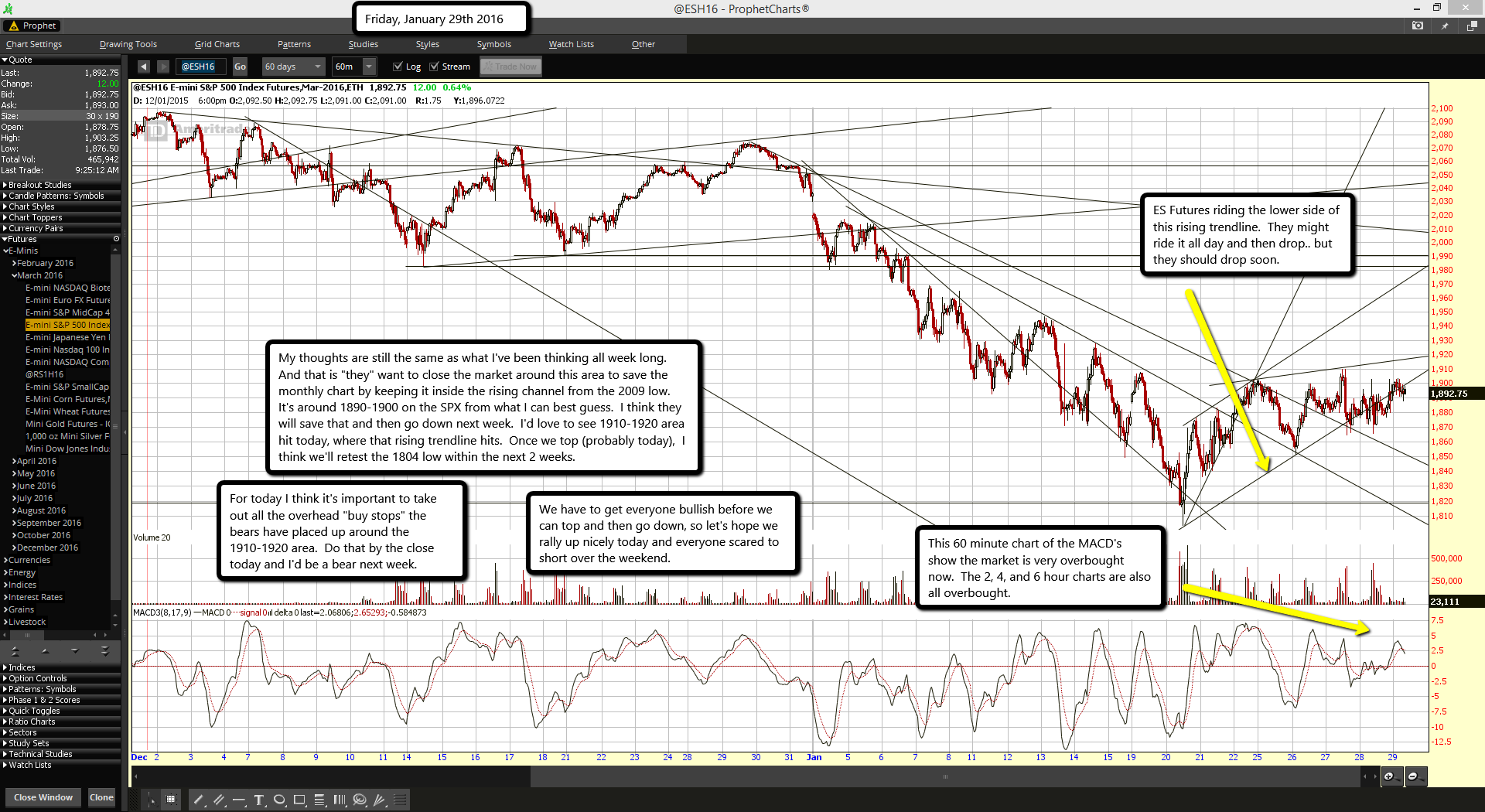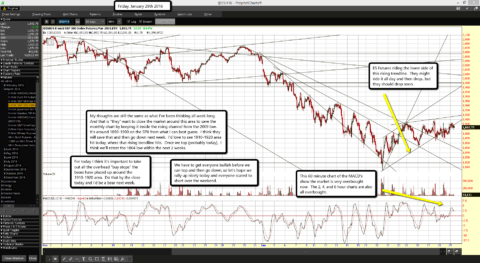The out-of-the-blue Japanese rate cut (which now means negative interest rates), combined with continued whispers of more easing by European Centrail bankers and even dovish indications from the U.S. Fed on Wednesday all cheered the free-money crowd, which is now hopeful more cash is headed its way. That served to lift all asset classes. We appreciate the break in the selling, but eventually ongoing earnings pressure and other stock fundamentals could keep a lid on stock market improvement.
However, this was a happy week. Emerging markets, often the beneficiary of easy money cash flows, saw the best performance this week, with funds up over 4%. Commodities were up 3.1%, stacking two good weeks in a row. Again, oil was a key driver, this time on some flimsy rumors that some producers might meet with the intent of limiting production. It could happen, but it doesn't seem to be the most likely case. However, speculators now realize selling short any commodity-related instrument isn't a guaranteed one-way street to riches. The rumors seemed to be enough to end the silly game of reducing oil price forecasts to be the lowest on The Street. The forecast race seems to have ended at $20 for now.
Even bonds did better this week, partially on weaker headline economic data, partly from a dovish Fed on Wednesday, and of course, the gift from the Bank of Japan. And the most recent world inflation data shows no new inflation threats in the immediate future, easing bondholder worries. Although the Fed continued to believe the U.S. economy will approach 2% inflation in the intermediate term, the 2016 oil swoon may have pushed out the day of reckoning, maybe by as much as six months.
Earnings news this week in the U.S. was mixed with a number of high-profile misses/guidance changes, including Apple (AAPL) and Amazon (AMZN). Without all the attention on the Bank of Japan, the U.S. Fed, and those supposed invites to an oil producer meetup, that earnings news would have probably meant another week of dismal equity market performance. The earnings news did, in fact, have a depressive effect on a couple of days, but the Bank of Japan swung things around on Friday. However, too many traders making the same simplistic bets in the same instruments may have caused some short covering on Friday, providing more fuel for the market.
U.S. economic news was mixed. The worst-looking data might have been the slow 0.7% GDP growth rate, down from 2.0% in the previous quarter. We had suspected this might take the market down on Friday when the data was released, but some weakness was well anticipated, and our Japanese friends focused everyone's attention elsewhere. Besides, there were a lot of quirky one-off events in the fourth quarter that took away the sting and set the economy up for a strong rebound, at least in early 2016.
Durable goods orders were a mess, too, but stripping out airliners, the short-term trends weren't nearly as bad as the headline 5% decline. Turning to real estate data, prices looked higher again and are now approaching 6% year-over-year growth, potentially enough to begin to limit sales. New home sales had another big month, helped along by some catch-up in required paperwork activity. Sales of homes not even started (versus off the lot) were even better, boding very well for the future. And pending home sales were fine, too, if not robust.
I continue to believe my 2.0%-2.5% overall GDP forecast for 2016 is still on target. At least until recently, my forecast was at the lower end of the consensus range, but certainly not by too much. It's more of the same growth as the last four years, perhaps with a small bias to the downside with continued demographic issues and an aging business cycle.
This status quo economic forecast is not meant to signal a steady stock market. That's too hard for me to predict; the economy is tough enough. I do have worries about slow world growth, currencies, and rising wage rates potentially hurting earnings growth. However, because so much multinational activity occurs outside the U.S., corporate earnings could fall a bit without damaging the U.S. economy and throwing workers out of a job. In addition, a fairly narrow set of stocks have drawn most of the investor interest, suggesting that all is not necessarily perfect in equity land.
Sequential real GDP growth slowed from 2.0% in the third quarter to 0.7% in the fourth quarter as widely expected and right on last week's GDPNow forecast--though that forecast was raised to 1.0% mid-week; they should have left well enough alone.
Although the headline number might not look good, it was a very quirky quarter. We will explain some of the quirks later. The much more reliable full-year over full-year growth rate was up 2.4% in 2015, identical to the 2.4% growth rate in 2014. During the six full years of the recovery, growth has averaged 2.1%. The long-term compound growth since 1950 has been 3.1%. Dramatically lower population growth, as well as an aging population (which tends to consume less), are largely behind this secular slowing. We believe these two factors will limit long-term growth to 2.0% to 2.5% at best over the longer term. In that light, Friday's GDP report was certainly no disaster.

Fixation on Quarterly Sequential Data Has to Go
Maybe this quarter will finally end the fixation on the quarterly sequential GDP calculation, the middle column in the table above. The quarterly GDP numbers in that column imply the economy has grown as much as 4.6% and shrank as much as 0.9%. Unbelievably, that is just the past two years, not even a whole economic cycle.
That just isn't economic reality. Job growth has been nearly steady at 2% for over five years. In today's age of temp and on-call workers, if the overall economy were really this volatile, we would have much more violent swings in employment data. And layoffs remain very near record low levels.
The first column, same-quarter to same-quarter growth, is much less volatile and perhaps representative. The fact that this column is dramatically less volatile suggests that faulty seasonal factors may be at work. When we try to compare winter quarters to winter quarters, we get much steadier results than when we try to make artificial adjustments to compare winter quarters to spring quarters.
Taking this one step further, the volatility nearly disappears if we consider full-year over full-year data, the last column above. This tends to reduce the effects of a hurricane, strikes, government shutdowns, or bad weather, as the good and bad average out over longer periods of time. Weather--too warm this fall and early winter, too rainy in Texas, and not enough snow--created a lot of volatility in 2015. In many cases, the detrimental event hit one quarter and the positive bounce happened in another. This year, import-export data was on a yo-yo because of a labor action on the West Coast. Tax law changes are another reason for such volatile economic data.
A lot of the quarterly volatility is also due primarily to two GDP components, inventories and net exports. These two categories are extraordinarily difficult to measure physically, and layers of calculations for changing prices compound the difficulty of correct measurement. Inventory swings, again in just the last two years, have taken away as much 1.3% from the quarterly GDP calculation and added as much as 1.1%. Net exports weren't much different, subtracting as much as 1.9% and adding as much as 0.1%. Remember these are on a base of GDP growth in a given quarter of negative 0.1% and positive 4.6%. Single-handedly or combined, these two factors are temporary GDP killers.
In the recent fourth quarter, these two factors combined took one full percentage point off of the GDP report. So instead of a normal looking 1.7% growth rate, we ended up with a 0.7% growth rate. However, unusually bad export and inventory data is often followed by exceptionally good data in the following quarter or two. Over a full year, the swings tend to wash out, as shown in the annual contribution table below. However, the export data did not completely wash out in 2015, perhaps related to the strong and genuine issues in the export sector.

While we are on the contribution table, it shows why we are so focused on the consumer. We endlessly mention that the consumer is 70% of the U.S. economy; however, this year the consumer accounted for 88% of GDP growth. The consumer did well in 2015, spending 3% more than in 2014 (contribution equals 3.1% growth times 69% of GDP, or 2.1%). Both goods and services continued to do well in 2015 and continued their positive long-turn upturn. However, services continue to gain share from goods, a trend that is likely to continue as the baby boomers age and consume more health and travel services, and millennials favor experiences over physical goods.
Business spending on equipment and software/intellectual capital hasn't done much over the last several years, generally growing 3% to 5% and representing 10% or so of GDP. It could be worse, but we are near the lowest business spending growth rate of the recovery. Slow economic growth and a lack of new physical products mean fewer new or expanded factories with more equipment are needed. Hence we suspect this category will continue a few tenths of a percent of growth every year, but not much more.
Business structure growth hasn't done a lot for the economy in the last four years, as retail trends toward online shopping and smaller office spaces have weighed on growth. However, there is still growth in 2015 in non-oil structures. Structures including oil wells took a big hit in 2015, as oil and gas spending on well-related structures fell as much as 50% in some quarters. Even in a small category, a 50% decline is enough to move GDP around. Though oil-related spending continued to decline through the fourth quarter, those declines are now getting smaller. Next year, the drag on the economy from oil well structures should be considerably less, letting the underlying growth in offices and factories shine through.
Residential spending, a tiny 3% of GDP, had a very good year, growing almost 9%, a nice improvement from growth of just 1.8% in 2014. Higher prices weighed heavily on 2014 results. Slower price growth in 2015 combined with higher wages helped affordability and home sales in 2015. Unfortunately, given tight housing inventories, it will be very hard to match this performance in 2016.
As we suspected, the government category (all levels) finally returned to the black in 2015, making its first positive contribution to GDP growth since 2010. At 17.5% of total GDP, declines in government spending have been a huge impediment to GDP growth. In past history, this has has happened only twice, and for very short periods of time, both following the winding down of a war. The state and local government sector grew at a 1.4% rate. The federal government saw a tiny shrinkage in 2015, though recent quarters have shown positive growth rates, setting up the data for more improvement in 2016.
Quarterly Data Had So Many Problems: Utilities, Autos, Gasoline Usage, and Delayed Home Closings
The headline quarterly GDP number had so many issues that discussing it is hardly worth the ink. The annual data above better represents the state of affairs. We have already mentioned the full point swing from inventories and net exports, though perhaps not every ounce of that swing is as fake as usual. Issues on the export side were potentially real, though likely compounded by typical measurement issues. Besides those two factors, low utility usage took 0.3% off of GDP, an almost unheard-of effect for such an often benign and routine category. Warm weather, the warmest in decades, in the normally heavy energy month of December really hurt the calculation. We would guess that we will get all of that 0.3% back in the first quarter, as weather normalizes.
Autos were another key category that swung negatively, with a 0.21% contribution swing between the third and fourth quarter. Both sales and production figures are suffering from terrible and unjustified seasonal factors, which we have discussed before (shifting summer shutdowns, odd holiday calendar, five-Sunday months). However, we would be less than honest if we didn't admit that these same factors probably artificially boosted the second and third quarter's economic indicators, including GDP. We caught some factors in our monthly reports but never put together the GDP impact. That could be part of the reason the year-over-year total GDP numbers look so stable while the quarterly data is on a yo-yo. Too many auto-related statistics were too high this summer and are too low now. The annual data is much more representative and leaves out all of the seasonal factors. Instead all of the monthly unadjusted numbers are just added together.
Somehow with consumers buying bigger cars and demonstrably driving more miles, gasoline sales were down in the fourth quarter, taking 0.1% off of GDP. Maybe it's those faulty seasonal factors again. Full-year gasoline sales were up. Plus, there was the large November problem with home closings and new paperwork requirements. That delayed many sales for a month, pushing down quarterly sales and brokerage commissions in the quarter.
We thought about putting all these factors in a table and claiming GDP was far higher than the reported 0.7% rate. But we felt that wouldn't be entirely honest, as some of the issues identified would suggest other quarters had GDP calculations that were too high. And perhaps the export adjustment and maybe part of the inventory swing went beyond the normal self-cancelling levels that we have seen before. Inventories might have gotten a little high, and the export market is more competitive.
We will say that we don't believe growth changed too much between the third and fourth quarter, and both were consistent with levels below the full-year growth rate, just a smidge under 2%. Unfortunately, those back-half growth rates were likely far enough below that 2.4% full-year rate that it may be more difficult to match the full-year 2.4% growth in 2016 than we would like. However, if weather or geopolitical events doesn't intervene, first- and second-quarter growth rates could see a substantial bounce, likely fooling a lot of people yet again--this time into thinking the economy is too strong.
Pending Home Sales Hang Tight
Pending home sales data is usually an excellent tool to forecast existing-home sales. There is generally a month or two of delay between when someone signs a contract on a home and when the home sale officially closes, giving us some insights into future months of existing-home sales.
It has also helped everyone correctly predict that the strong drop-off in existing-home sales in November was likely a one-off event related to new paperwork requirements, because there was not a corresponding drop in pending home sales.
Pending sales have been relatively flat for the last four months, after a modestly strong spring and summer selling season. However, the data confirms reports from the National Association of Realtors that growth in 2016 could be lackluster. Pending home sales in December were up about 3% on a year-over-year, three-month moving-average basis. That would suggest similar growth in existing-home sales in 2016, at least early 2016. That's off a little from the 7% growth in existing-home sales for all of 2015. It's certainly not enough of a difference to worry about, but no boom is in sight, either. Inventories that are nearing 10-year lows are likely a major reason home sales are slowing, and prices are increasing.

 Armstrong Henry H Associates Inc. lowered its position in Coca-Cola (NYSE:KO) by 3.1% during the fourth quarter, according to its most recent Form 13F filing with the SEC. The fund owned 290,200 shares of the company’s stock after selling 9,284 shares during the period. Coca-Cola comprises approximately 2.4% of Armstrong Henry H Associates Inc.’s holdings, making the stock its 11th largest position. Armstrong Henry H Associates Inc.’s holdings in Coca-Cola were worth $12,467,000 at the end of the most recent quarter.
Armstrong Henry H Associates Inc. lowered its position in Coca-Cola (NYSE:KO) by 3.1% during the fourth quarter, according to its most recent Form 13F filing with the SEC. The fund owned 290,200 shares of the company’s stock after selling 9,284 shares during the period. Coca-Cola comprises approximately 2.4% of Armstrong Henry H Associates Inc.’s holdings, making the stock its 11th largest position. Armstrong Henry H Associates Inc.’s holdings in Coca-Cola were worth $12,467,000 at the end of the most recent quarter.























